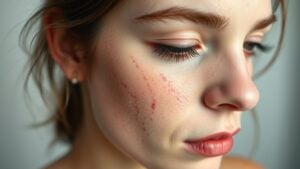Broken blood vessels on the face, often called spider veins, appear as thin red or purple lines on the cheeks, nose, or chin. These tiny, visible veins happen when capillaries near the skin’s surface widen or burst. While harmless, they can make people feel self-conscious.
Causes range from genetics and sun damage to rosacea, harsh weather, or even aggressive skincare. Some medical conditions, like liver disease or high blood pressure, may also play a role. Lifestyle habits, including alcohol use or rough scrubbing, can worsen the issue. Comprehending the triggers helps in managing and preventing them. Treatment options exist, but realizing why they appear is the initial step.
What Are Broken Blood Vessels on the Face?
Broken blood vessels on the face, also called spider veins or telangiectasia, are tiny, visible red or purple lines that appear just beneath the skin. These occur when dilated capillaries near the surface widen, making them more noticeable. They often appear on the cheeks, nose, or chin, resembling thin, branching threads.
While usually harmless, they can cause self-consciousness due to their prominent appearance. Facial flushing—sudden redness from increased blood flow—can worsen their visibility, especially in those with sensitive skin. Factors like genetics, aging, or environmental triggers contribute to their development.
Though they don’t typically cause pain, some could experience mild irritation. Comprehending their nature aids in managing expectations and seeking appropriate care when needed.
Common Causes of Red Veins on Cheeks
Red veins on the cheeks frequently manifest as tiny blood vessels near the skin’s surface widen and become more visible. Several factors contribute to this, including genetics, which can make some people more prone to fragile capillaries. Hormonal fluctuations, especially during pregnancy or menopause, can also weaken vessel walls. Environmental triggers like sun exposure or extreme temperatures might exacerbate the issue. Below is a breakdown of common causes:
| Cause | Effect |
|---|---|
| Genetics | Inherited weak vessel structure |
| Hormonal changes | Increased blood flow, vessel dilation |
| Sun damage | Thinned skin, visible capillaries |
| Harsh weather | Temporary vessel expansion |
Understanding these causes helps identify personal risk factors and manage redness effectively.
Medical Conditions Linked to Facial Broken Blood Vessels
Why do some medical conditions make those tiny red lines on the face more likely to appear? Hormonal imbalances, like those observed in pregnancy or menopause, can weaken blood vessel walls, rendering them more prone to breakage.
Conditions such as rosacea, a chronic skin disorder, cause persistent redness and visible veins due to inflammation. Genetic predisposition also plays a role—some individuals inherit delicate capillaries that rupture easily under stress or temperature changes.
Autoimmune diseases, like lupus, may trigger facial redness by damaging small blood vessels. Liver disease can lead to spider veins by affecting circulation, while high blood pressure strains fragile facial capillaries. Even allergies or eczema contribute by causing repeated irritation.
Comprehending these underlying conditions helps explain why broken blood vessels appear and how they connect to overall health.
Lifestyle Factors That Contribute to Broken Capillaries
Prolonged sun exposure weakens capillary walls, increasing the risk of visible broken blood vessels.
Frequent alcohol consumption dilates blood vessels, making them more prone to damage over time.
Rough scrubbing or aggressive skincare routines can irritate delicate facial skin, worsening capillary fragility.
Sun Exposure Risks
Although many people enjoy spending time outdoors, frequent sun exposure can damage the delicate blood vessels in the face, making them more prone to breaking. UV light damage weakens the skin’s collagen and elastin, thinning the walls of capillaries and increasing their visibility.
Over time, this leads to broken blood vessels, especially on the cheeks and nose. Sun protection essentials, like broad-spectrum sunscreen, hats, and shade, help prevent this damage. Even on cloudy days, UV rays penetrate the skin, so daily protection is key.
Those with fair skin or a history of sunburns are at higher risk. Red, spidery veins often appear as a result of prolonged exposure without proper care. Protecting the skin promptly reduces the chances of developing these visible veins later.
Alcohol Consumption Effects
As alcohol enters the bloodstream, it causes blood vessels to expand, including the tiny capillaries in the face. Excess alcohol intake leads to repeated dilation, weakening these delicate vessels over time. This can result in increased facial flushing and visible red veins, especially on the cheeks. Chronic drinking worsens the issue, as the skin’s ability to repair itself diminishes. Those with fair skin or rosacea might notice the effects sooner.
| Factor | Effect on Capillaries | Long-Term Risk |
|---|---|---|
| Frequent drinking | Persistent dilation | Permanent damage |
| High alcohol content | Intense flushing | Broken vessels |
| Dehydration | Skin thinning | Easier to rupture |
| Genetics | Higher sensitivity | Faster visible damage |
| Combined with heat | Further expansion | Worsened redness |
Moderation helps reduce these risks.
Harsh Skincare Habits
Aggressive scrubbing or using rough exfoliants could appear to be a swift means of attaining radiant complexion, yet these practices can recoil through injuring sensitive facial capillaries. Overexfoliation and over-cleansing strip the skin’s protective barrier, leaving blood vessels vulnerable to damage. Harsh skincare habits often worsen redness and broken capillaries, especially for those with delicate skin.
Physical exfoliants: Scrubs with jagged particles create micro-tears, irritating capillaries.
Chemical overload: Strong acids (like glycolic or salicylic) used too frequently weaken skin resilience.
Hot water: Washing with steaming water dilates vessels, increasing rupture risk.
Tugging motions: Rough towel-drying or aggressive makeup removal strains fragile veins.
Over-cleansing: Washing too often depletes natural oils, making capillaries more visible.
Gentle alternatives—like lukewarm water, soft cloths, and pH-balanced cleansers—help maintain skin health without compromising capillaries.
How to Prevent Broken Blood Vessels on the Face
Preventing broken blood vessels on the face starts with protecting the skin daily from sun exposure and environmental damage. Avoiding harsh treatments like aggressive exfoliation or extreme temperatures can also reduce the risk.
Gentle skincare routines and consistent protection help maintain healthier skin over time.
Protect Skin Daily
Since broken blood vessels on the face often develop from daily habits, protecting the skin requires consistent care. Gentle routines and preventive measures can minimize redness and fragility.
Use a hydrating moisturizer daily to strengthen the skin barrier and reduce irritation.
Follow a sun protection routine with broad-spectrum SPF 30+ to shield against UV damage, a major cause of broken capillaries.
Avoid extreme temperatures—hot showers or icy winds can stress delicate facial vessels.
Pat skin dry gently instead of rubbing to prevent unnecessary friction.
Choose fragrance-free products to lower the risk of irritation that weakens capillaries.
Small adjustments in daily skincare can make a significant difference in preventing broken blood vessels. Consistency is key to maintaining healthy, resilient skin.
Avoid Harsh Treatments
Though broken blood vessels can appear to be a trivial concern, harsh treatments can exacerbate their appearance or even provoke new ones. Aggressive exfoliants, hot water, and abrasive scrubs weaken delicate facial skin, making blood vessels more visible.
Instead, gentle cleansers help maintain the skin’s natural balance without stripping moisture. Overusing strong acids or alcohol-based products can also compromise barrier protection, leaving skin vulnerable to irritation and redness. Even excessive rubbing with towels or rough fabrics can contribute to the problem.
Opting for lukewarm water, soft cloths, and fragrance-free formulas reduces stress on capillaries. Dermatologists often recommend avoiding steam treatments and harsh peels, as heat and friction worsen broken vessels. By choosing milder skincare routines, individuals can protect their skin’s integrity while minimizing further damage.
Treatment Options for Visible Red Veins
Whenever visible red veins appear on the face, they can feel frustrating, but several treatment options exist to reduce their appearance.
- Laser treatment: Targets broken blood vessels with focused light, sealing them without damaging skin. Multiple sessions might be needed.
- Topical creams: Formulas with vitamin K or retinoids can strengthen capillaries and fade redness over time.
- Sclerotherapy: A solution is injected to collapse the vein, often used for larger spider veins.
- Electrodesiccation: A tiny electric current zaps the vein, causing it to fade. Best for small areas.
- Intense Pulsed Light (IPL): Uses broad-spectrum light to reduce redness and improve skin tone gradually.
Consulting a dermatologist can ensure the safest, most effective approach for individual skin types.
Conclusion
Like delicate threads woven too fine, broken blood vessels on the face recount stories of sun, stress, and time. While they could appear permanent, their presence doesn’t define you—just as cracks in pottery don’t erase its beauty. With care and the right choices, their appearance can diminish, allowing confidence to shine through. After all, skin, like life, carries marks of experience, but it’s the glow beneath that truly matters.




